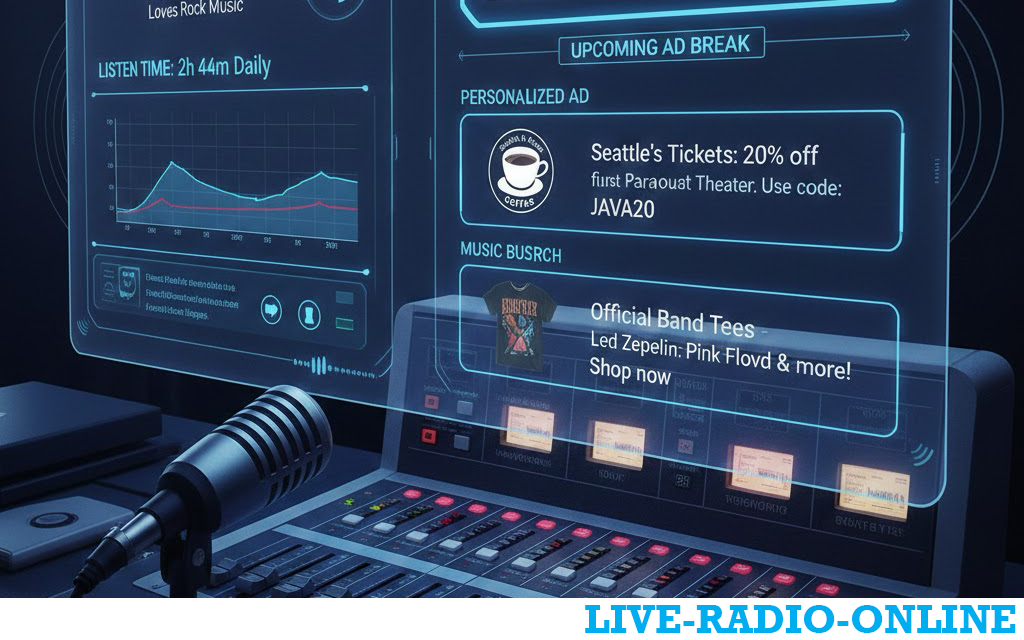
Personalized in-stream ads for radio stations represent the future of radio advertising, blending the mass reach of traditional radio with the targeting power of digital marketing.
Here’s a comprehensive breakdown of how it works, the benefits, the challenges, and the future outlook.
What Are Personalized In-stream Ads?
Imagine two people listening to the same radio station, at the same time, in the same city. One hears an ad for a local skate shop, while the other hears an ad for a new minivan. That's personalized in-stream advertising.
It's the delivery of targeted audio commercials to specific listeners based on their demographic, geographic, behavioral, or contextual data, seamlessly inserted into the live or on-demand audio stream.
How Does It Work? The Technology Behind It
This personalization is primarily for digital streams (via station apps, websites, or platforms like iHeartRadio or TuneIn), not the traditional terrestrial (FM/AM) broadcast.
-
Data Collection:
-
First-Party Data: The radio station's own app or website can collect data like age, gender, ZIP code, and listening habits (e.g., you always listen to the morning drive show).
-
Listener Registration: When a user creates an account on an app like iHeartRadio, they provide demographic information.
-
Contextual Data: Time of day, location (via IP address or GPS), type of content being listened to (e.g., a sports talk show vs. a classical music program).
-
-
Ad Insertion:
-
Dynamic Ad Insertion (DAI): This is the core technology. Instead of a "hard-coded" ad on the terrestrial feed, the digital stream has a pre-defined "ad slot." As the stream reaches that slot, the ad server selects and delivers a personalized ad in real-time to that specific listener.
-
-
The Ad Server's Role:
-
In milliseconds, the ad server receives a request saying, "I have a listener who is Male, 35, in Chicago, listening on his smartphone during his commute."
-
The server then checks its pool of ads and chooses the most relevant one (e.g., an ad for a Chicago-based coffee chain promoting a breakfast sandwich).
-
The selected ad is played to the listener, while a different ad is played to someone else.
-
Key Benefits
| For Listeners | For Advertisers | For Radio Stations |
|---|---|---|
| Relevance: Ads are more likely to be for products and services they care about. | Efficiency: Less money wasted on irrelevant audiences. Higher Return on Ad Spend (ROAS). | New Revenue Stream: Can charge a premium for targeted ads compared to generic ones. |
| Less Repetition: Reduces the fatigue of hearing the same irrelevant ad repeatedly. | Performance Tracking: Digital-style metrics (impressions, click-throughs, conversions) are now possible. | Competitive Edge: Competes directly with digital giants like Google and Spotify for ad dollars. |
| Better Experience: A more useful and less intrusive advertising experience. | Granular Targeting: Target by location, demographics, and even psychographics. | Data Monetization: Leverages listener data to create new, valuable advertising products. |
| Brand Safety: More control over which content their ads are played alongside. | Future-Proofing: Adapts the traditional radio model to the digital age. |
Challenges and Hurdles
-
Privacy Concerns: Collecting and using listener data must be done transparently and in compliance with regulations like GDPR and CCPA. Listener trust is paramount.
-
Technical Infrastructure: Requires significant investment in ad tech, data management platforms, and seamless integration with broadcast systems.
-
The Terrestrial Divide: This doesn't work for traditional FM/AM radio. The value proposition is for the digital stream, which can create a two-tiered advertising system for a station.
-
Scale for Hyper-Local Ads: While great for national campaigns, it can be tricky for a very small local business to create and target multiple ad variations, though programmatic platforms are making this easier.
-
Listener Perception: Some listeners might find it "creepy" that the radio seems to know them, similar to early reactions to online behavioral ads.
Real-World Examples
-
A National Auto Brand: Instead of running one generic ad, they can target:
-
Listeners in Snowy Regions with an ad for their 4x4 SUV.
-
Listeners in Urban Areas with an ad for a compact, fuel-efficient model.
-
Listeners known to be Sports Fans with an ad that airs during a sports talk show.
-
-
A Fast-Food Chain: Target listeners within a 3-mile radius of a specific location during lunchtime (11 AM - 2 PM) with a promo code.
-
A Video Game Company: Target males aged 18-34 who listen to electronic or rock music stations with an ad for their new action game.
The Future Outlook
Personalized in-stream ads are not a fad; they are the logical evolution of radio advertising. We will see:
-
Tighter Integration with Programmatic Audio: Automated buying and selling of this ad inventory will become the norm.
-
Voice-Activated Integration: As listening moves to smart speakers, the potential for interactive, voice-targeted ads will grow (e.g., "Alexa, tell me more about that offer").
-
Advanced Creative Optimization (ACO): Dynamic creative that changes parts of the ad (like the voiceover or offer) based on the listener's profile in real-time.
Conclusion
Personalized in-stream ads transform radio from a blunt mass-marketing instrument into a sharp, scalable, and measurable digital channel. For listeners, it promises a less annoying experience. For advertisers, it delivers precision and accountability. And for radio stations, it unlocks a new, high-value revenue stream essential for survival and growth in the digital era.


